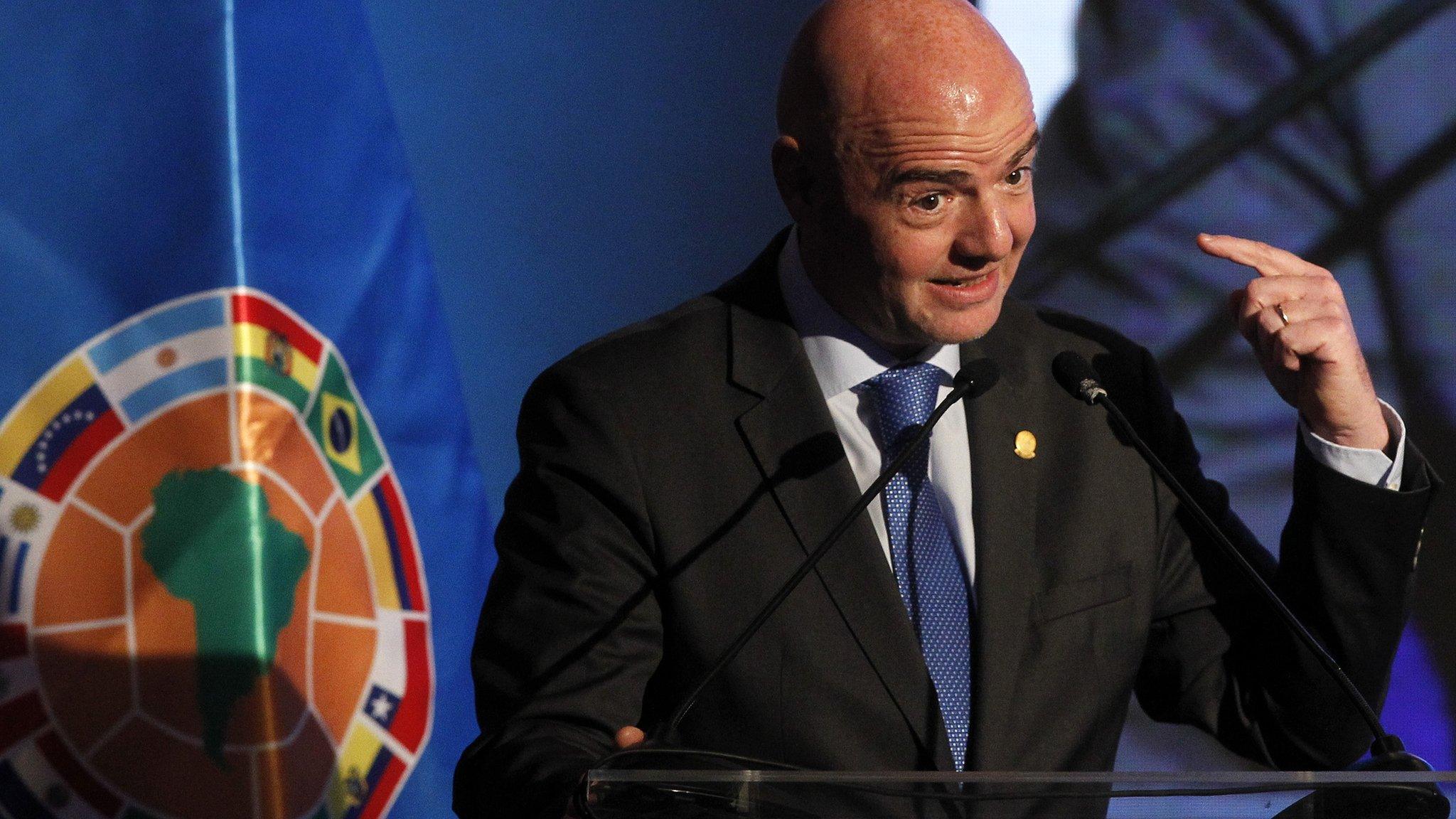World Cup 2018: How will VAR work in Russia?
- Published
- comments
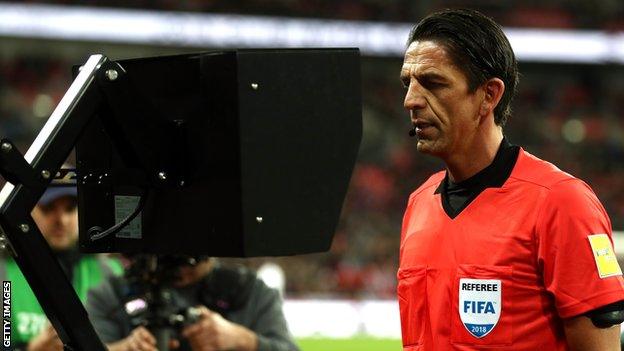
German referee Deniz Aytekin awarded Italy an injury-time penalty in the 1-1 friendly draw with England in March
At some point during this World Cup, history will be made.
A referee will use two fingers to mark out a rectangle in the air or press his hand to his ear.
Back in a Moscow control room a four-strong team of officials will plug into 33 camera angles, including eight in super slow motion and four in ultra slow motion.
The referee on the ground and his "eye in the sky" will dissect an incident and the VAR (video assistant referee) system will be in use for the first time at a World Cup.
If we have learned anything from VAR since it was introduced to top-level football for the first time in Australia in April 2017, that is unlikely to be the end of the story.
What is VAR?
The theory behind VAR is simple: more accurate decisions, more often, and at the most important points in matches.
The on-pitch referee makes all the same calls, at the same speed and unaided, as he would without the system in place.
However the VAR - a current or former top referee - is in place to check decisions on four sorts of incidents:
Goals, including 'missed' attacking offences in the build-up
Penalties awarded and not awarded, including 'missed' attacking offences in the build-up
Direct red cards
Cases of mistaken identity where the wrong player is shown a red or yellow card
The referee can accept the information relayed through his earpiece by the VAR team, an option usually reserved for objective calls of fact such as if a player is offside.
Or, for more subjective decisions such as red cards and penalty-box fouls, he can review the footage on a pitchside television monitor before deciding whether to change his initial call.
The VAR team will also proactively contact the referee if they spot "a clear and obvious error" around these four types of incident or a "serious missed incident" - usually off-the-ball violence.
The referee can then decide whether or not to have a review - this is where the replay is officially consulted and is indicated by the referee showing the TV signal.
Has it been a success?
A study by Belgian university KU Leuven, external into 1,000 competitive matches using VAR suggests the system is a success in its broad aims.
According to its calculations, the system improves decision accuracy from 93% to 98.8%. Nine per cent of matches were shown to have had a different, and probably fairer, result than would have been the case without VAR.
But the individual incidents where VAR faltered, failed or spiralled into near-farce are its most memorable moments.
May's A-League Grand Final is perhaps the one that will give World Cup organisers the most nightmares.
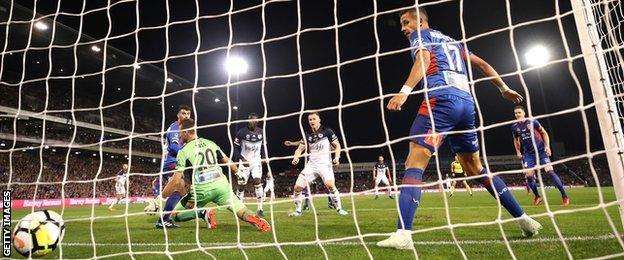
Newcastle Jets concede the only goal of the A League Grand Final, but VAR should have ruled it out
Nine minutes into the showpiece of the Australian domestic season, Melbourne Victory's James Donachie set up Kostas Barbarouses for the first and, it turns out, only goal of the game.
However viewers at home on Fox Sports could clearly see on replays that Donachie was offside in the build-up to the goal.
Why hadn't the VAR team intervened on what seemed a "clear and obvious" error?
Former Perth Glory coach Kenny Lowe posted a theory on social media, external that they had been enjoying a "nice glass of wine, chilling out, enjoying corporate sandwiches with two eye patches on".
The reality was more mundane, but pretty damning.
A technical glitch mean that the relevant camera angle, while shown on television coverage, had not been available to the VAR team.
It was not the first time that things went awry.
In the Portuguese top flight in February, an apparently offside goal stood because a giant flag waved by a fan blocked a camera., external
In a big Bundesliga relegation clash in April, the referee recalled the teams from the dressing rooms at half-time to award a penalty after VAR officials belatedly spotted a handball late in the first half.
Is this the most bizarre use of VAR so far?
In the FA Cup - where VAR has been tested in England this season - television viewers were shown a graphic that suggested Manchester United's Juan Mata had a goal disallowed against Huddersfield for offside on the basis of some almost-comically squiggly and askew lines.
Hawk-Eye, which runs the system in England, later explained that, while the graphic shown on television was incorrect, the correct decision had been made on the basis of a correct graphic seen by VAR officials.
FA Cup: Mata's goal ruled out by VAR at Huddersfield in the FA Cup fifth round
All of these could be put down as technical teething problems.
But the system has also been criticised for how it is explained, as well as how it works.
Fifa has resolved to communicate better what is happening during the VAR process. An official will be dedicated to providing informative graphics for the big screens in the stadium and television viewers back home while a decision is being reviewed.
If they can crack that and VAR can produce more dead-eyed calls like when it awarded Leicester's Kelechi Iheanacho a goal against Fleetwood in the FA Cup on a hairline offside call in January, then the World Cup could cement the system as a permanent fixture in the game.
How would VAR have affected the 2014 World Cup? A referee's view
Former Premier League referee David Elleray is the technical director of the International Football Association Board - the body that determines the laws of the game - and drew up the protocol for the system's use.
Here he guides us through how the system would have been used if it had been in place at the last World Cup.
Nigeria 1-0 Bosnia Herzegovina - 21 June
In the 22nd minute, with the scoreline still blank, Bosnia striker Edin Dzeko darts in on goal only to have his strike ruled out for offside.
Bosnia's Edin Dzeko is denied a goal against Nigeria
David Elleray: "Offside decisions can be some of the hardest for officials on the pitch to make, especially in cases such as these where Nigeria defender Efe Ambrose moves towards the halfway line and Dzeko runs in the opposite direction towards goal.
"In real time, the defender and attacker moving in the opposite directions at speed makes the attacking player look clearly offside when often he is not.
"VAR can be an enormous help for factual, objective decisions like this.
"Timing is also crucial.
"If the referee blows the whistle before Dzeko shoots, play would technically stop and he would not be able to review the (wrong) offside and award the goal.
"By waiting for the outcome of the attack, the offside can be reviewed and the goal potentially allowed.
"That is why in Russia you may see referees delay blowing the whistle after the flag goes up, allowing the scoring chance to develop and keeping their options open."
Italy 0-1 Costa Rica - 20 June
A misplaced pass and a piece of miscontrol from Giorgio Chiellini turns Italian possession in the Costa Rica half into a clear-cut chance for Joel Campbell at the other end in an instant. Campbell goes down in the box as Chiellini attempts to recover, but the referee is inevitably well behind play...
Costa Rica's Joel Campbell denied penalty against Italy
David Elleray: "If the VAR believed that Chilean referee Enrique Osses had made a 'clear and obvious error' in not giving a penalty, he would recommend that the referee reviews the incident on the pitchside monitor - this is an 'on-field review'.
"For subjective decisions like this one the referee usually needs to see the replay to make a decision in keeping with how he has dealt with similar incidents earlier in the game.
"If I was watching that incident in the video operation room, where the VAR works, I would have recommended a review for a penalty.
"Although Campbell does move slightly to his left and into Chiellini to bring the foul, the Italy defender does not make any real attempt to win the ball. As the referee will not have seen this level of detail, an on-field review would be my recommendation if I was the VAR."
Italy 0-1 Uruguay - 24 June
Just short of the hour mark, Italy's Claudio Marchisio chases the ball into a challenge on Egidio Arevalo, spinning around and leaving his opponent in a heap. Referee Marco Rodriguez has no hesitation in showing red.
Italy's Claudio Marchisio sees red against Uruguay
David Elleray: "In this situation, we would have what we call a 'silent check' which is when the VAR automatically checks a situation but usually does not speak with the referee.
"The VAR would look at the incident and not judge if the referee was right to show Italy's Marchisio red, but judge if he was clearly wrong to do so.
"Marchisio in this incident clearly goes over the top of the ball with his right foot, planting his studs into the leg of Uruguay's Arevalo.
"That is the clear red card offence of serious foul play - using excessive force and/or endangering the safety of an opponent.
"If the VAR does decide to speak to the referee he would probably say "decision correct" or "check complete" meaning there is no need for a review."
Last but not least
Cases of mistaken identity - the fourth and final category of incident where VAR can be used to review a decision - are far rarer.
The last World Cup did not contain any such incidents.
But at Germany 2006, English referee Graham Poll memorably and mistakenly booked Croatia's Josip Simunic three times in the second half before sending him off.
World Cup moments: Poll's blunder
In a Premier League game in 2014, Andre Marriner wrongly showed the red card to Arsenal's Kieran Gibbs rather than his team-mate Alex Oxlade-Chamberlain after a goalline handball against Chelsea.
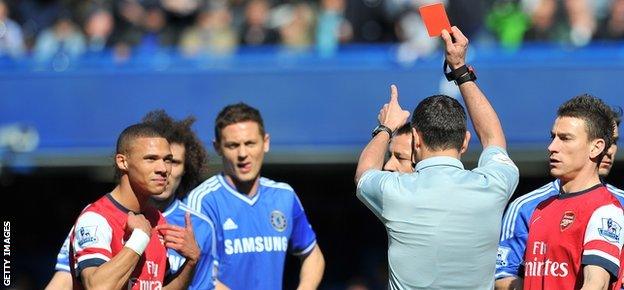
Neither Gibbs nor Oxlade-Chamberlain faced any suspension after Marriner's mistake
And in June 2017's Confederations Cup, VAR was used to correct referee Wilmar Roldan's error in sending off Cameroon captain Sebastien Siani rather than his team-mate Ernest Mabouka against Germany.

One of the first international uses of VAR was a case of mistaken identity
David Elleray: "These are very rare incidents and occur when a referee penalises a team but then gives the wrong player of that team a red or yellow card.
"The VAR automatically checks the identity of the player receiving the card rather than the incident itself, unless it is a wrong red card.
"This automatic checking is a key part of the VAR working in the background and occurs for all reviewable incidents - goals, penalties and straight red cards.
"Mistaken identity is the only area where the referee can proactively ask for assistance; in such cases he can ask for help about which player should receive the red or yellow card."
- Published19 April 2018

- Published29 March 2018
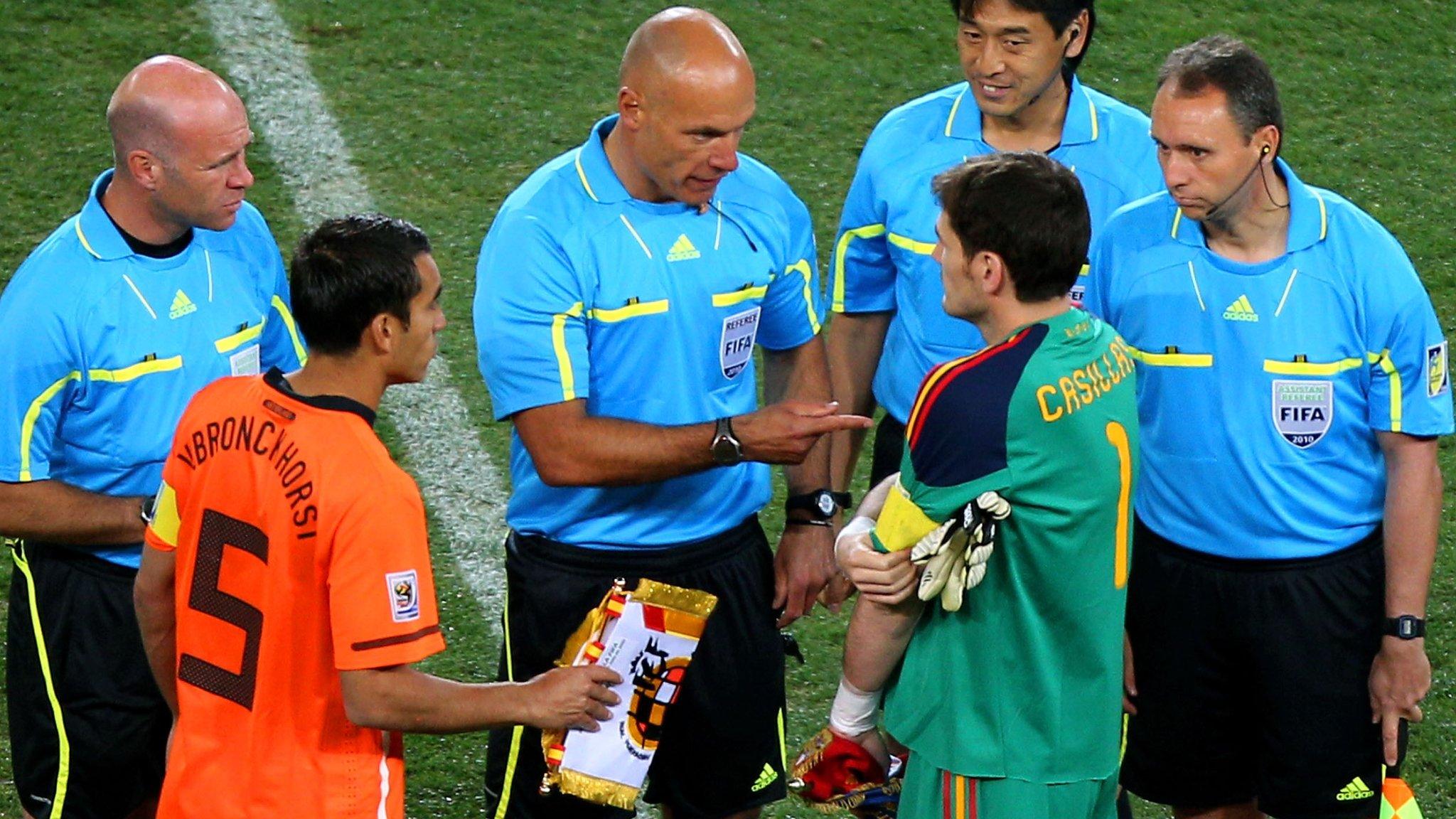
- Published26 April 2017
